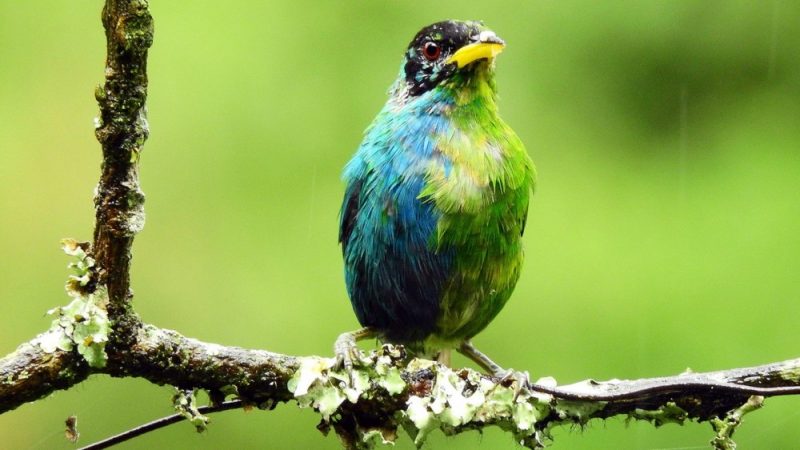These birds break the sex binary like it’s nothing

What’s the weirdest thing you learned this week? Well, whatever it is, we promise you’ll have an even weirder answer if you listen to PopSci’s hit podcast. The Weirdest Thing I Learned This Week hits Apple, Spotify, YouTube, and everywhere else you listen to podcasts every-other Wednesday morning. It’s your new favorite source for the strangest science-adjacent facts, figures, and Wikipedia spirals the editors of Popular Science can muster. If you like the stories in this post, we guarantee you’ll love the show.
Check out Weirdest Thing’s new page on Reddit to meet fellow Weirdos!
FACT: These birds break the sex binary like it’s nothing
By Amanda Reed
Hamish Spencer, zoologist and distinguished professor at the University of Otago, was vacationing in Colombia when ornithologist John Murillo pointed out an interesting bird perched on a feeding station. The bird in question was a green honeycreeper, but it didn’t look quite like any honeycreeper they’d seen before. The right half of the bird was blue, resembling males of the species, and the left half was green—the hue typically seen in females.
This special honeycreeper is one of many animals that display bilateral gynandromorphism, a trait where animals present both male and female characteristics even though their species usually have distinct sexes.
Other birds have displayed bilateral gynandromorphism. In 2019, a cardinal with male and female plumage was spotted in Erie, Pennsylvania. In 2020, researchers in Pennsylvania found a gynandromorphic rose-breasted grosbeak that displayed male plumage on the right and female plumage on the left.
These birds, and other binary-breaking animals like clownfish and leaping lesbian lizards, are proof that nature is less into simple labels than you think. For more on the way the natural world consistently shatters our idea of how things like sex should work, check out these gene-stealing salamanders, this super-sexy slime mold, and Rachel’s book about the weird and wonderful evolution of sex.
FACT: Frogs do a lot more screaming than you might think
By Rachel Feltman
Litter leaf frogs, inhabitants of the Brazilian rainforest, employ a unique defense mechanism: emitting screams at frequencies beyond human hearing. Recent research has revealed that these unassuming amphibians employ ultrasonic screams, undetectable to human ears, to ward off potential threats like bats and rodents. They also do a funky little maneuver before unleashing their battle cries.
So, why does this frog scream? Well, scientists have a couple of theories. One idea is that it’s trying to scare off as many predators as possible by employing a broad range of frequencies. Another notion is that the scream might actually attract other, bigger predators so they’ll deal with whatever is threatening the frog.
And in case you’re wondering: yes, some frogs scream at frequencies that are completely audible to us, for better and for worse.
FACT: One scientist tried to prove that fungi could talk (sort of)
By Erica Brozovsky
Fungi come in all shapes and sizes, from the microscopic organisms living in and around our bodies to the largest living thing on Earth: 3.5 square miles of Armillaria ostoyae in a forest in Oregon. There are millions of types of fungi, but if you’re not a mycologist, when you think of fungi, you probably imagine mushrooms. Sometimes delicious, sometimes deadly, sometimes trippy, mushrooms are the fruiting bodies of certain types of fungi.
If you were thinking, “How does a fungus get to be 3.5 square miles?!” The answer is the web of mycelium (made up of long, underground structures of thread-like filaments called hyphae) that links fungal colonies with the soil, similar to how the nervous system connects things in our bodies. And taken together mycelium composes what is called the mycorrhizal network which connects plants together to share resources and communicate. It’s sometimes called the wood wide web!
Much like the world wide web, the wood wide web allows fungi to communicate, sending nutrients, chemicals, and electrical signals. One scientist studied those electrical impulses and through his findings claims that mushrooms communicate with each other in ‘words’ similar to human language. You can learn more about these potentially mouthy mushrooms by listening to this week’s episode.










